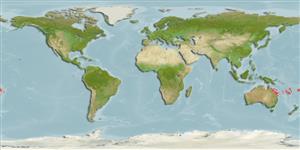Actinopterygii (ray-finned fishes) >
Perciformes (Perch-likes) >
Lethrinidae (Emperors or scavengers) > Monotaxinae
Etymology: Gymnocranius: Greek, gymnos = naked + Greek, kranion = skull (Ref. 45335). More on author: Ogilby.
Environment / Climate / Range
Ecology
Marine; reef-associated; non-migratory; depth range 8 - 40 m (Ref. 2295). Subtropical, preferred ?; 15°S - 25°S
Western Pacific: Australia (east coast of southern Queensland and the southern half of the Great Barrier Reef). The name bitorquatus has been applied to this species, particularly by Australian authors.
Size / Weight / Age
Maturity: Lm ? range ? - ? cm
Max length : 40.0 cm TL male/unsexed; (Ref. 2295); common length : 35.0 cm TL male/unsexed; (Ref. 2295)
Dorsal
spines
(total): 10;
Dorsal
soft rays
(total): 10;
Anal
spines: 3;
Anal
soft rays: 9 - 10. Inner surface of pectoral fin without scales. Overall color is silver or whitish, often light brown or olive on upper sides. Each scale on sides has a brown spot forming longitudinal rows. Fins are uniformly clear to slightly yellowish. Fresh specimen have scattered brown flecks on sides. A blackish bar that runs through the eye may also be evident.
Generally solitary over sand or rubble areas adjacent to reefs . Feeds mainly on benthic invertebrates. Sometimes has a distasteful iodine flavor; however, untainted fish are good to eat.
Life cycle and mating behavior
Maturity | Reproduction | Spawning | Eggs | Fecundity | Larvae
Carpenter, K.E. and G.R. Allen, 1989. FAO Species Catalogue. Vol. 9. Emperor fishes and large-eye breams of the world (family Lethrinidae). An annotated and illustrated catalogue of lethrinid species known to date. FAO Fish. Synop. 125(9):118 p. Rome: FAO. (Ref. 2295)
IUCN Red List Status (Ref. 115185)
CITES (Ref. 94142)
Not Evaluated
Threat to humans
Harmless
Human uses
Fisheries: minor commercial
More information
Common namesSynonymsMetabolismPredatorsEcotoxicologyReproductionMaturitySpawningFecundityEggsEgg development
ReferencesAquacultureAquaculture profileStrainsGeneticsAllele frequenciesHeritabilityDiseasesProcessingMass conversion
Tools
Special reports
Download XML
Internet sources
